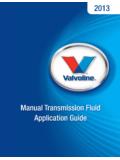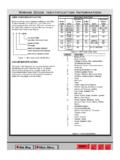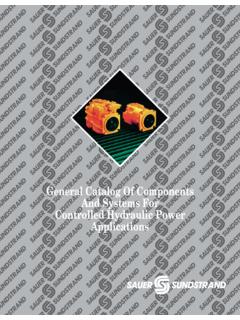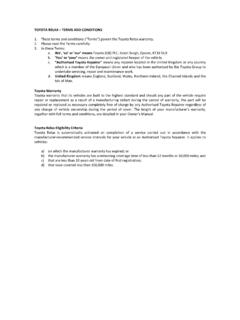Transcription of Technical Service Information
1 DODGE RAM TRUCKS 68 RFE TRANSMISSIONFOUND BEHIND (L6) and Diesel EnginesFigure 16= Six Forward Speeds8= Relative Torque CapacityR= Rear Wheel DriveFE= Fully Electronic21 719 04A1 72PB77 05485T 14:T J720810 4I75 4 1 :4T77R210B FEP14A 597043 Copyright 2011 ATSGAUTOMATIC TRANSMISSION Service GROUPT echnical Service InformationTITTJ177720548 14:10:44P52119704AB RFE704 Bar Code LabelID Numbers Also Etched IntoCase Pan Rail Here1777 20548 P52119704 ABPartNumberBuildDateSerialNumber{{{Flui d Requirements"Mopar ATF+4"CLUTCH APPLICATION CHARTSELECTORPOSITIONLO/REVCLUTCHUDCLUTC HSECONDCLUTCHODCLUTCHGEARRATIOLOW :1 ONONONONONONONONONONONONONONONONONONONON HOLDHOLDHOLDREVERSENEUTRALOD-1ST(1)-1ST( 2)-1ST(2)-2 NDOD-2 NDOD-3 RDOD-4 THOD-5 THOD-6 THOD-LIMP(2)-LIMPON*ON*ONL/R Clutch is on only with the output shaft speed below 150 RPM.}}}
2 *Figure 2 UnderdriveClutchOverdriveClutchReverseCl utchSecondClutchFourthClutchLow/ReverseC lutchLow SpragClutch4 Copyright 2011 ATSGAUTOMATIC TRANSMISSION Service GROUPT echnical Service InformationCOMPONENT LOCATIONS The operation of the 68 RFE is very similar to the Chrysler 45 RFE. Drive range provides reduction 1st, 2nd, and 3rd gear, direct 4th gear and overdrive 5th and 6th gears. The shift into 5th and 6th gear occurs only after the transmission has completed the shift into 4th gear. Upshifts into 5th and 6th gear will be delayed when the fluid temperature is below C (40 F) or above 115 C (240 F). The Input Clutch Housing retains the "single-sided" underdrive clutch, "single-sided" overdrive clutch and the reverse clutch. It is set up almost identical to the 41TE transaxle , except much larger.
3 The 68 RFE also contains seperate holding clutches, such as the 2nd clutch, 4th clutch and the "single-sided" low/reverse clutch. This unit also uses one freewheel device called the low sprag. To achieve its different gear ratios, the 68 RFE applies different combinations of two clutch packs at a time, as shown in Figure 2. In Park and Neutral, only the low/reverse clutch is applied. Refer to the chart in Figure 2 for the clutches that are applied for each shift lever (gear) position. Another feature of the 68 RFE is the three planetary gear sets, as shown in Figure 2, that are all equipped with 6 pinion carriers to accommodate the Diesel engine. These planetary gear sets also provide a deeper 1st and reverse ratio. All gear ratios are also shown in the chart in Figure OPERATIONSOLENOID OPERATION**Modulating (EMCC) if the Converter Clutch has been signaled.
4 **Off Below 8 MPH, On Above 8 = Normally = Normally Applied * L/R Clutch is on only with the output shaft speed below 150 APPLICATION CHARTSELECTORPOSITIONLR/CCSOLENOIDUDSOLE NOIDODSOLENOID2nd CLUTSOLENOID4th CLUTSOLENOIDM ulti-SelectSOLENOIDLine PressureSOLENOIDPark/NeutralPark/Neutral (1)-1ST *ONONONOFFOFFOFFOFFOFFOFFOFFONON**OFFONO NONONONONONONONONONOFFONONOFFONONONM odulatingModulatingModulatingModulatingM odulatingModulatingModulatingModulatingM odulatingModulatingREVERSEFAILSAFEOD-1 STOD-2 NDOD-3 RDOD-4 THOD-5 THOD-6TH**Figure 35 Copyright 2011 ATSGAUTOMATIC TRANSMISSION Service GROUPT echnical Service Information Solenoids are used to control the L/R, 2C, 4C, UD and OD friction elements. The Reverse clutch is controlled by the manual valve in the valve body and line pressure.
5 The Multi-Select solenoid is used primarily to provide 3rd gear and reverse "limp-in" operation. The TCM energizes or operates the solenoids individually by grounding the return wire of the solenoid as necessary. When a solenoid is energized, a fluid passage is opened or closed (vented or applied), depending on its default operating state. The result is an apply or release of a friction element. Refer to the chart in Figure OPERATION Vehicles equipped with the 68 RFE and a Diesel engine use a Transmission Control Module (TCM) housed in the New Generation Controller (NGC) utilizing only the C1 and C4 connectors. The TCM controls all of the transmission functions. The controller is located at the rear of the engine compartment, near the right inner fender, as shown in Figure 12.
6 The Powertrain Control Module (PCM) does not control the transmission. The electronic components of the 68 RFE transmission consist of various sensors and switches as input Information to the TCM, that the TCM uses to determine the appropriate gear ratio and shift schedule points. There is also the associated wiring, fuses, relays, connectors, splices and grounds for the transmission to function as designed. A complete transmission wiring schematic has been provided for you in Figure 10. The final output from the TCM is to the six shift solenoids and the line pressure control solenoid located in the Solenoid Body/Transmission Range Sensor assembly and bolted on the valve body as shown in Figure 9. The solenoids in this transmission are unique in that some are normally vented and some are normally applied and this is also illustrated in Figure 9.
7 The TCM also communicates with other control modules, such as the PCM, and the New Generation Controller (NGC) modules currently use PCI or CAN C bus. The TCM recieves power from two sources, fused battery power to pin 18 (C4 connector) and fused ignition switch input to pin 30 (C1 connector). The TCM also has several grounds to complete its electrical circuit, as shown in Figure 2011 ATSGAUTOMATIC TRANSMISSION Service GROUPT echnical Service InformationLIMP-IN MODE OPERATION The TCM has the ability to monitor all transmission related electrical components and if it detects a problem, takes appropriate action, and most of the time results in the TCM setting a Diagnostic Trouble Code (DTC). Whether this results in MIL illumination, or Limp-in Mode operation, depends on the type of DTC that was set.
8 If the TCM determines that transmission damage may result from the DTC type that was set, the TCM will shut off the ground signal to the transmission control relay which will shut off all power to the transmission and the vehicle will be in Limp-in Mode Operation. When in Limp-in Mode Operation, with the shift lever in the "Drive" position the transmission will be in 4th gear, and if the shift lever is moved to "2" or "L" position the transmission will be in 2nd gear. This will allow the driver to manually shift the transmission to Limp home. Note: Vehicles equipped with Electronic Range Select (ERS) do not provide 2nd gear limp-in, because the shift lever has no "2" or "1" shift lever positions. The hydraulic control system design, without any electronic assist, provides the 68 RFE transmission with PARK, REVERSE, NEUTRAL, and FOURTH gears based solely on driver selection.
9 This design allows the vehicle to be driven in "limp-in" mode (4th gear) in the event of a total electronic control system failure, or a situation that the TCM recognizes as potentially damaging to the transmission (DTC Stored).ADAPTIVE LEARNING The 68 RFE transmission uses an "Adaptive Learning" feature which allows the TCM to modify the clutch apply rate to maintain consistant shift quality. This is done based on the amount of wear on the friction elements. The TCM then adjusts the duty cycle of the shift solenoids to achieve the smoothest possible upshifts and downshifts. The TCM adjusts the "Clutch Volume Index" when a shift change takes place to optimize clutch to clutch timing. Clutch Volume Index is described on Page 16, along with proper clutch volumes and clutch clearances for the 68 RFE transmission shown in Figure Control Module (TCM)OutputSpeedSensorInputSpeedSensorC4 33C434C432 TCM7 Copyright 2011 ATSGAUTOMATIC TRANSMISSION Service GROUPT echnical Service InformationINPUTS TO THE TCM Input and Output Shaft speed Sensors - are located on the left side of the transmission and are illustrated in Figure 5.
10 The input shaft speed sensor reads input shaft speed off of a tone wheel on the input clutch housing. As the teeth of the tone wheel pass the sensor coil, an AC voltage is generated and sent to the TCM. The TCM interprets this Information as input shaft rpm. The output speed sensor generates an AC signal in a similar fashion, though its coil is excited by rotation of the parking gear teeth. The TCM interprets this Information as output shaft rpm. The TCM compares the input and output speed signals to determine the following: Transmission gear ratio. speed ratio error detection. Clutch Volume Index calulation. Torque Converter Clutch slippage. Both speed sensors are the same and will interchange. New speed sensors, when checked for resistance, read 535 ohms at room temperature.







